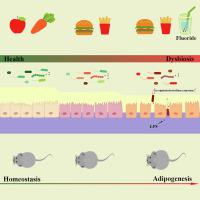Journal of Advanced Research ( IF 10.7 ) Pub Date : 2022-10-29 , DOI: 10.1016/j.jare.2022.10.010 Guijie Chen 1 , Yujia Peng 1 , Yujie Huang 1 , Minhao Xie 2 , Zhuqing Dai 3 , Huimei Cai 4 , Wei Dong 1 , Weiqi Xu 1 , Zhiyong Xie 1 , Dan Chen 1 , Xia Fan 1 , Wangting Zhou 1 , Xuhui Kan 1 , Tingting Yang 1 , Chunxu Chen 1 , Yi Sun 1 , Xiaoxiong Zeng 1 , Zhonghua Liu 5

|
Introduction
Fluoride is widely presented in drinking water and foods. A strong relation between fluoride exposure and obesity has been reported. However, the potential mechanisms on fluoride-induced obesity remain unexplored.
Objectives and methods
The effects of fluoride on the obesity were investigated using mice model. Furthermore, the role of gut homeostasis in exacerbation of the obesity induced by fluoride was evaluated.
Results
The results showed that fluoride alone did not induce obesity in normal diet (ND) fed mice, whereas, it could trigger exacerbation of obesity in high-fat diet (HFD) fed mice. Fluoride impaired intestinal barrier and activated Toll-like receptor 4 (TLR4) signaling to induce obesity, which was further verified in TLR4−/− mice. Furthermore, fluoride could deteriorate the gut microbiota in HFD mice. The fecal microbiota transplantation from fluoride-induced mice was sufficient to induce obesity, while the exacerbation of obesity by fluoride was blocked upon gut microbiota depletion. The fluoride-induced bloom of Erysipelatoclostridium ramosum was responsible for exacerbation of obesity. In addition, a potential strategy for prevention of fluoride-induced obesity was proposed by intervention with polysaccharides from Fuzhuan brick tea.
Conclusion
Overall, these results provide the first evidence of a comprehensive cross-talk mechanism between fluoride and obesity in HFD fed mice, which is mediated by gut microbiota and intestinal barrier. E. ramosum was identified as a crucial mediator of fluoride induced obesity, which could be explored as potential target for prevention and treatment of obesity with exciting translational value.
中文翻译:

氟化物诱导的肠漏和丹毒梭菌繁殖介导高脂饮食喂养小鼠肥胖的加剧
介绍
氟化物广泛存在于饮用水和食品中。据报道,氟化物暴露与肥胖之间存在密切关系。然而,氟化物引起的肥胖的潜在机制仍有待探索。
目标和方法
使用小鼠模型研究氟化物对肥胖的影响。此外,还评估了肠道稳态在氟化物引起的肥胖加剧中的作用。
结果
结果表明,单独使用氟化物不会导致正常饮食(ND)喂养的小鼠肥胖,但可能会导致高脂饮食(HFD)喂养的小鼠肥胖加剧。氟化物损害肠道屏障并激活 Toll 样受体 4 (TLR4) 信号传导诱导肥胖,这一点在 TLR4 −/−小鼠中得到了进一步验证。此外,氟化物可能会恶化 HFD 小鼠的肠道微生物群。来自氟化物诱导的小鼠的粪便微生物群移植足以诱导肥胖,而氟化物对肥胖的加剧在肠道微生物群耗竭时被阻止。氟化物引起的丹毒梭菌繁殖是导致肥胖加剧的原因。此外,还提出了通过茯砖茶中的多糖进行干预来预防氟化物引起的肥胖的潜在策略。
结论
总的来说,这些结果提供了第一个证据,证明氟化物与高脂饮食喂养小鼠肥胖之间存在全面的串扰机制,该机制是由肠道微生物群和肠道屏障介导的。E. ramosum被确定为氟化物诱导肥胖的关键介质,可作为预防和治疗肥胖的潜在靶标进行探索,具有令人兴奋的转化价值。



























 京公网安备 11010802027423号
京公网安备 11010802027423号